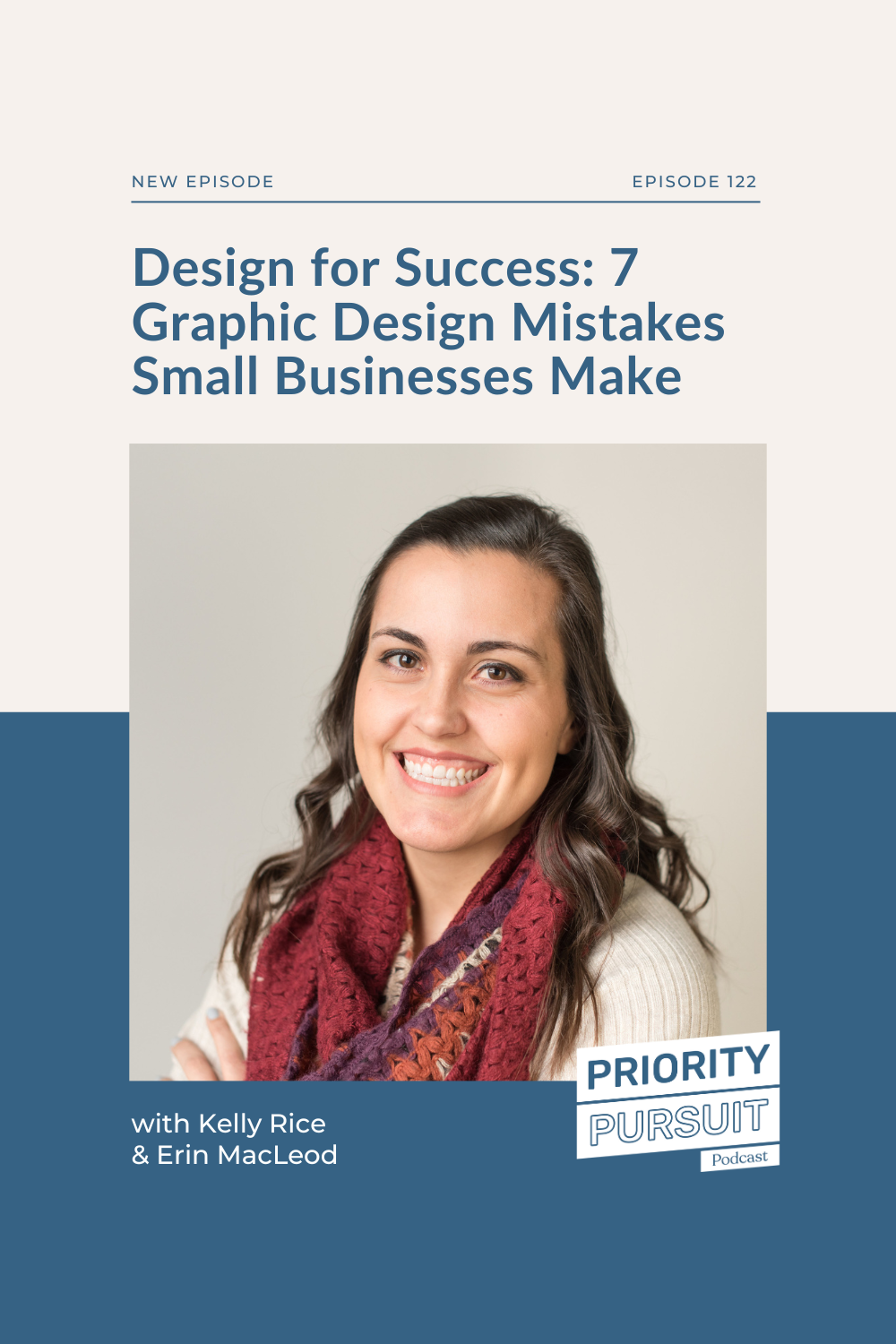Spotify | Apple Podcasts | Amazon Podcasts | Stitcher
When you’re looking for a product or service and you come across a business with a poorly designed website, generic-looking social media posts, or marketing materials that look like they were designed by Clippy—the animated paperclip from Microsoft in 1999—do you purchase from that business?
Probably not.
The fact of the matter is that graphic design matters for small businesses, and it can be the difference between prospects seeing your company as professional and credible and ultimately deciding to do business with you or moving on and working with one of your competitors.
You work too hard for poor graphic design to stand in the way of sales.
That’s why on this episode of Priority Pursuit, we are joined by Treefrog’s Creative Director Erin MacLeod as she breaks down the seven most common graphic design mistakes small businesses make so that you can avoid them and see success.
The Start of Your Visual Brand
Before you start working on website design, social media graphics, or literally any other design pieces, you need to determine your visual brand. Otherwise, your visual brand as a whole will lack consistency—which doesn’t convey professionalism and can prevent business growth.
A visual brand is more than just a logo—it’s a collection of design elements and visuals that give a company its unique look and feel. It’s what helps you instantly recognize a popular shoe brand, restaurant, or any other brand. Your visual brand is important because it more or less sets the stage for how your company is perceived and remembered.
While your logo and color palette are helpful and necessary, they are only pieces of your visual brand. Your visual brand consists of everything that you see. Your logo, fonts, color palette, graphic elements, and imagery are all included and work to bring the visual side of your overall brand to life.
That said, before you begin to establish your visual brand, you need to know who you are as a small business and who your audience is so you can figure out how you can serve them well through design. In other words, you need to write your Marketing Guiding Statements and identify your ideal clients.
It may seem strange to be talking about clarifying your messaging when we are discussing graphic design—but this strategy document is a basis for bringing a visual brand to life.
It helps a professional designer—or you, if you’re creating your branding elements internally—to decide which colors, fonts, graphic elements, imagery, etc. to use so that your ideal clients will be more likely to notice, remember, and engage with your brand and business.
As we’ve said before, clear messaging is the key to effective marketing. But, if poor design detracts or distracts from your messaging, you will likely miss out on business.
Seven Graphic Design Mistakes Small Businesses Make
With so many elements going into your visual brand, it’s easy for things to get lost in the mix and mistakes to be made. To help make the process easier, we’re going over the seven biggest graphic design mistakes small businesses make.
These mistakes can apply to your website, social media graphics, other digital graphics, print pieces, or any other design materials.
1. Poor Design Hierarchy
Probably the most common mistake that we see is poor design hierarchy. When you design anything—especially if it includes a lot of text—you want to make sure that all of the elements you use in your design are created in a way that helps the viewer easily read and understand the piece.
For example, you don’t want all of the words or elements on a page to be the same size and weight. That would make it hard to know what the purpose of the piece is and what information is most important. And, because viewers or readers would likely find the design of this piece frustrating, your prospects will probably stop reading—meaning you miss out on business simply because of poor design.
There are a lot of ways to create a strong design hierarchy with font size and weight, colors, contrast, spacing, perspective, etc. But, basically, you want to make sure that everything designed for your small business has an impactful design hierarchy so that your prospects don’t miss out on your message.
If you want to learn more about design hierarchy, check out our blog post “5 Tips for Using Typographic Hierarchy.”
2. Design Overload
Another one of the common graphic design mistakes we see small businesses make is design overload. Basically, many small businesses or inexperienced graphic designers have a tendency to make their marketing pieces busy and crowded, which—like poor design hierarchy—can make it difficult for potential customers to actually pay attention to and retain the information you want them to know.
To prevent design overload, there are a few things you can do.
Include White Space
White space is negative space or space free from design elements or text. This might not sound very exciting, but it’s very important to have and use your white space well because it helps bring a focus to your design and helps prevent people from feeling overwhelmed.
Add Spacing and Padding
Another way to prevent design overload is by including adequate spacing and padding. Spacing and padding are simply the space within and around a design element. They’re similar to white space but a little different because you want to keep spacing and padding in mind as you add each and every element to a design.
Again, you don’t want your designs to feel cluttered and difficult to read, and including adequate spacing and padding can help with that.
Limit Typefaces
Another way to prevent design overload is to limit the number of typefaces you use. In case you aren’t familiar with what a “typeface” is, a typeface refers to a specific style of lettering—such as Helvetica—that encompasses multiple fonts—such as Helvetica italic, bold, etc.
For your visual brand as a whole, you typically don’t want to have more than three typefaces. Typically, as we design visual brands, we choose a font for headings, a font for paragraph text, and then—usually—some kind of more bold or distinguished font that we can use in headings or as a design element.
Any more than three fonts tends to be distracting—causing design overload—but three fonts usually help keep designs and visual brands as a whole consistent, effective, and professional.
Keep the Design Simple
Arguably the most effective way to prevent design overload is to keep the design simple. Now, simple doesn’t mean plain. Keeping a design simple means that you’re visually able to convey your message clearly and concisely without a ton of excessive or distracting design elements.
Also, staying simple doesn’t mean that something isn’t designed well. It just means that it isn’t over the top. You don’t need a ton of bells and whistles to get people’s attention and to get your message across. In fact, the busier your design is, the less likely people will be to engage with your marketing piece because it will likely be difficult to comprehend and come across as unprofessional.
Overall, design overload—like poor design hierarchy—can cost you business, so make sure your designs aren’t unnecessarily cluttered and busy.
3. Accessibility
Many small businesses fail to design with accessibility in mind, which is a shame for a few reasons.
First of all, it’s honestly unloving and unkind not to design using best accessibility practices, because you’re preventing those with disabilities—such as visual impairments, cognitive disorders, or motor disabilities—from being able to consume your content. Everyone should have equal access to information, and as a result, you want to design accordingly.
Also, when you don’t design with accessibility in mind—specifically on your website—your SEO can be harmed. Many accessibility practices align with best SEO practices. In fact, Google and other search engines tend to reward websites that are accessible and user-friendly, which leads to higher search engine rankings and more visibility for your website and content.
Now, there are several ways to design with accessibility in mind. For example, use high-contrast colors, provide alt text for images, and avoid relying solely on color to convey information.
For example, if you design a document or webpage with hyperlinks, keep in mind that someone with a visual impairment may be scrolling through the document or webpage but be unable to see that your links are different colors than the rest of your text. Instead of just making your hyperlinks a different color, underline them as well. This will help ensure that your hyperlinks can be used and accessed by all.
We could honestly do a whole episode about design accessibility. But, if you’d like a full list of accessibility design best practices, we want to encourage you to check out Princeton University’s accessibility checklist. This list is very comprehensive but also concise and clear.
4. Poor Image Selection
As you design something, every image you choose needs to relate to the content at hand. If it doesn’t, there will be a disconnect in your design.
For example, let’s say you’re designing a PDF guide about the best content marketing strategy for small businesses. You’re likely going to want to utilize a lot of images of people writing and typing on computers and happy-looking business owners experiencing growth.
We’d also argue that it’s important to keep your image style as consistent as possible. There are all kinds of photo styles out there, and none are necessarily bad, but having a clean image with natural skin tones next to a dramatic, warm image with deep shadows is going to create a disconnect in your visual brand. We highly recommend deciding what you want your brand’s photo style to be and only using images that fit that criteria.
Also, we want to note that when it comes to image selection, one of the biggest mistakes we see small businesses make is overusing stock images. Stock images are helpful if used well and in a way that aligns with your brand. But, as a small business, only using stock images can make your brand and business feel impersonal, generic, and cold—and can even cause prospects to question if you’re a legitimate business.
In fact, 82% of people trust a company more if it uses “real” imagery instead of stock photos on its website and in its other marketing materials. Because of this, at Treefrog, we highly recommend hiring a brand photographer to take custom photos of you, your team, your office, and whatever else is relevant to your business.
This way, you’ll have a gallery full of real photos that meet your marketing needs, have a consistent photo style, and help you build trust with your prospects.
5. Spelling & Grammar Errors
This next one might go without saying, but another one of the common graphic design mistakes we see small businesses make far too often is putting out marketing materials with spelling and grammatical errors.
Marketing materials with such mistakes can have super negative effects on a business’s credibility. After all, as human beings, we tend to fixate or get distracted by mistakes. As a result, if a design piece has a spelling or grammatical error, those looking at your marketing materials will likely focus on the error and miss your message.
Also, spelling and grammar errors can erode the trust and credibility of a business. Prospects are likely to associate errors with a lack of expertise and reliability, which can lead to doubts about the company’s ability to fulfill its promises.
Basically, if your marketing materials include grammar and spelling errors, prospects are likely to think, “If they can’t even use spell check, how can I possibly expect them to deliver a great product or service?”
Now, to be fair, not all of us are grammar and wordsmiths. But, before you put out marketing materials of any kind, please have someone review your materials for grammar and spelling errors—preferably someone with writing experience and who is highly detail-oriented.
For example, at Treefrog, absolutely nothing we design for ourselves or our clients is published, posted, or sent to the printer until our content department reviews the piece.
6. Not Being Consistent with Your Visual Brand
Another big graphic design mistake small businesses make is not being consistent with their visual brand. Brand consistency is important because it helps you build brand equity with your customers.
Think about Apple. You can usually spot an Apple ad pretty quickly—even if you don’t see the Apple logo immediately—because every design piece they produce includes clean lines, simple fonts, dynamic imagery, and primarily white, black, and shades of gray—which makes their overall visual brand clean but elegant.
Basically, Apple has built brand equity by being consistent with their visual brand on all platforms, including product design, web design, ads, and any and everything else they produce.
While Apple may be one of the world’s largest businesses, small businesses should strive for the same kind of consistency with their visual brands. Because, again, consistency helps build brand equity, trust, and recognition for your company.
7. Not Building Versatility into Design
Last but not least, we regularly see small businesses fail to build versatility into their visual brand.
Essentially, small businesses tend to design a logo, pick a color palette, and maybe choose a font or two but fail to think about how these brand elements will work across all platforms—such as their website, social media ads and graphics, apparel, print pieces, business cards, and whatever other marketing materials they may need.
Building a versatile visual brand can be tough, especially if you’re not regularly creating full brand identities. But, in order to keep your brand consistent, it’s so important to build a visual brand that can thrive in all needed mediums.
What Your Small Business Needs
With Canva and so many template and AI design resources out there, many small businesses question whether they should try to take advantage of these resources for their graphics and their visual brand or hire a graphic designer.
Honestly, it depends.
Between templates and AI, there are a lot of design resources out there. And, every small business starts somewhere. If you can’t afford a professional graphic designer right now, take advantage of these options.
But, keep in mind that overuse of templates can start to become generic and prevent your company from standing out. And even with templates, design can still be very time-consuming—especially considering not every template is going to work for every brand.
As a small business owner or leader, your time is very valuable. And, even though there are time-saving options, unless you’re a designer, worrying about design likely isn’t a good use of your time. As soon as you can, we highly recommend hiring a freelance or in-house designer. This way, you can ensure design for your business is top-notch and spend your valuable time focusing on other important aspects of your business.
Links & Resources Mentioned in This Episode
- Try ShowIt for One Month for Free
- Learn More About Treefrog’s Small Business Marketing Resources & Services
- Join the Priority Pursuit Facebook Community
- Follow or DM Treefrog Marketing on Instagram
- Follow or DM Kelly Rice on Instagram
- Follow or DM Victoria Rayburn on Instagram
The Priority Pursuit Podcast is a podcast dedicated to helping small business owners define, maintain, and pursue both their personal and business priorities so they can build lives and businesses they love.
You can find The Priority Pursuit Podcast on Spotify, Apple Podcasts, Amazon Podcasts, Stitcher, and wherever you listen to podcasts.
Did you enjoy this episode?
If so, pin it to save it for later! Follow us on Pinterest for more marketing, business, branding, and boundary-setting strategies!






